The heat exchanger – if this is your first time hearing this term, it might sound a bit complicated since it seems very technical. And for most people, technical equals complicated. However, the heat exchanger is not as complicated as it seems. Its functions and features are among the simplest to understand, though they are very important.
It is always best to learn a thing or two about your furnace and the heat exchanger. This can help you understand why certain things in your furnace are the way they are and how to take care of them.
This article will help you understand everything you need to know about the heat exchanger, what they do in your furnace, how they work, how to choose the best furnace heat exchanger for your furnace – based on quality and function – and how to maintain it.
What Is A Furnace Heat Exchanger?
First, a heat exchanger is a device that transfers heat from one fluid to another. But, in the case of a furnace, it transfers heat from one gas to another. In your furnace, the transfer of heat is done from a warmer gas to a cooler one.
This means that it’s the component that turns the gases distributed to your furnace into heat. So if the heat exchange in your furnace goes bad, the obvious result will either be; not enough heat or no heat at all.
How Does The Heat Exchanger Work?
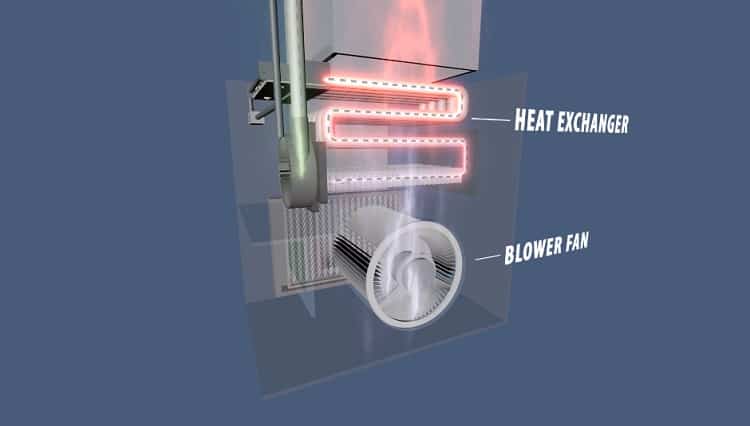
Once the furnaces’ gas is ignited, the combustion heat circulates through the heat exchanger. The heat exchanger is where the heat is created. It operates by allowing gasses of different temperatures to interact with each other. This enables the heat transfer from the warmer gas to the cooler gas.
This process continues until both gasses come to a balanced temperature. Once the heat is ready, the inducer motor and fan move the heat from the heat exchanger into your home once the heat is ready. And as you know, the furnace transfer across your home through the ducts. If the furnace’s heat exchanger fails, your gas furnace will not operate properly.
Types Of Furnace Heat Exchanger
There are three different types of furnace heat exchangers. Although they all work to get the same result, they operate in different ways. Their difference is based mainly on what medium they exchange heat with.
Below is a list of the three heat exchanger types, their operation method, and their pros and cons.
Shell And Tube Heat Exchanger
A shell and tube heat exchanger is one of the most commonly used heat exchanger types. It uses a series of tubes to exchange heat in the furnace. It allows gas to flow into the pipes while heating them by pumping air or gas around or over them.
There are two main parts of the heat exchanger, the tube part, which is series of metal tubes, and the shell part surrounding them. The cool gas flows through the tube, while the hot gas flows through the shell part of the heat exchanger to heat them.
Pros
- Resistant to scale formation – Shell-and-tube heat exchangers are more resistant to scale formation. This means that you only need to clean them less frequently than other types of the heat exchanger.
- Easy power regulation – Power can be increased or decreased. You can do this by adjusting the number of sections, length, and diameter of the pipes.
- Long-Lasting – In a normal case, the heat exchanger can last as long as 15 years. With proper care and maintenance, your furnaces heat exchanger can last up to 20 years. The heat exchanger, in most cases, can determine how long your furnace will last.
Cons
- Medium efficiency – The efficiency value of the shell and tube heat exchanger is only 70%. This means that only 70% percent of the gas can be turned into heat; the remaining 30% goes to waste.
- High maintenance requirements – The shell and tube heat exchanger is not easy to maintain.
Plate Heat Exchanger
The plate heat exchanger functions by circulating fluid between a series of plates. It is made of stainless steel and folded plates. The plates are arranged in a row, side by side.
In the furnace, the plate heat exchanger is arranged in pairs. Each pair creates a channel through which the first gas can flow. Between each pair, there’s a passage through which the second gas can pass through. The effectiveness of the heat exchange depends on the number of plates installed.
Pros
- High efficiency- Because the heat exchanger has a large surface area. It is able to turn as much gas into heat as possible, which makes it highly efficient. The efficiency rate of the plate heat exchanger reaches up to 90%. That is higher than the tube and shell heat exchanger.
- Compactness – The device is chosen based on the amount of heat required. When there are fewer plates, the differences are smaller; the differences are more significant when there are more plates.
- Proper heat transfer – The temperature approach of the plate heat exchanger is improved. The direction of flow is counter-current.
Cons
- Stressful To clean – Before you can clean the plate heat exchanger, you have to disassemble the whole thing.
- Does not last long – It is very easy for the plate heat exchanger to get clogged. Once it gets clogged without being cleaned, the damage might be permanent. Without cleaning, the maximum service life of the plate heat exchanger is only three years.
How To Choose The Best Heat Exchanger For Your Furnace
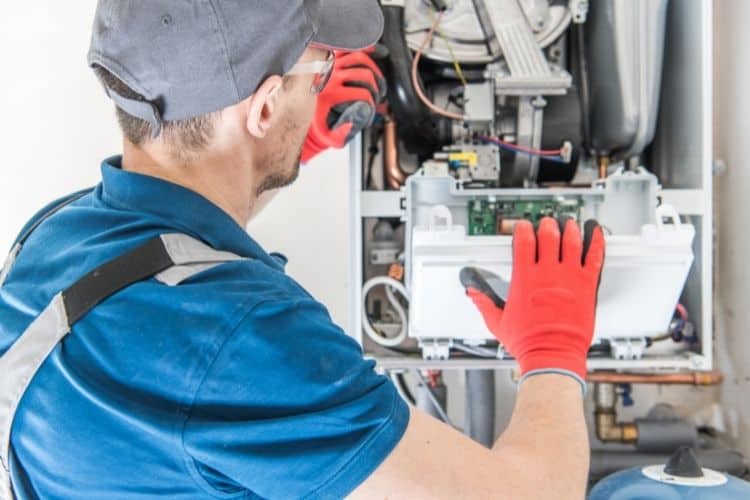
When choosing a heat exchanger for your furnace, there are a few criteria to consider. The best type of heat exchanger depends on the design parameters, fluid characteristics, space, and budget.
- First, you have to confirm the functions that the heat exchanger will perform. There are several types of heat exchangers in the market. So you have to make sure that the heat exchanger you’re purchasing is compatible with your furnace. Do not hesitate to contact a trained technician if you get confused.
- Pressure limits – the heat exchanger’s pressure limits (high and low) may vary throughout the heating process.
- The fluid flow capacity – make sure it’s a heat exchanger that is built specifically for gas.
- Required materials – Some heat exchangers may require special materials in sudden situations, such as an unexpected rise in temperature.
- Thermal fluid properties and product mix – A corrosion-resistant substance may be required if the heating or cooling fluid is prone to fouling.
- Space – Available space is a determinant of which heat exchanger is compatible with your furnace.
- Maintenance Requirements – Based on housekeeping procedures, it is best to choose a design that’s easy to clean. Also, one that is easy to repair relatively.
Signs That Your Furnace Heat Exchanger is Bad
Your furnace relies on the heat exchanger to supply heat air throughout the house. It is one of the most important parts of the furnace. When the heat exchanger goes bad, it could cause the furnace to break down, exposing your home to health and safety risks.
Here are some signs you need to watch out for in order to maintain your furnace properly and avoid more significant problems.
Note: Do not hesitate to contact a trained professional as soon as you notice any of the signs below.
Strange Smells
If you notice any unusual odors are coming from your heat exchange, it could be a sign of malfunction. The heat exchanger often produces strange and strong odors when it is not functioning correctly. This odor is similar to formaldehyde.
Soot Accumulation
If your heat exchanger is cracked, it builds up white soot in or around the burners of your furnace.
Cracks
If you see corrosion or cracks in other parts of your furnace, such as the inducer motor, it means the heat exchanger is in bad shape. Be sure to get in touch with a trained technician immediately.
Change in Flame Appearance
In a typical case, the flame of the furnace is usually blue. However, if your furnace’s flame changes to orange or yellow, then there’s a problem. You must contact a trained professional immediately.
Loud Noise
You are likely to hear a rattling noise from your furnace if the heat exchanger is cracked. Because it is made from metal, the cracks will expand and cause rattling, popping, or banging noises. If you notice any of this noise from your heat exchanger, don’t hesitate to contact a trained technician.
Can You Repair a Heat Exchanger?
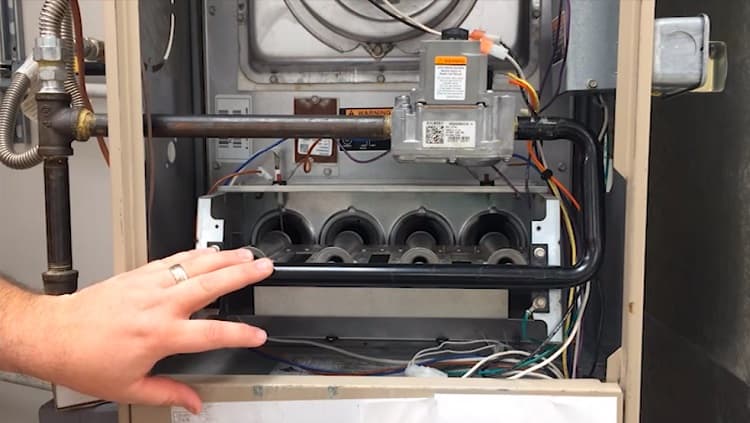
A damaged heat exchanger not only reduces the efficiency of your furnace but can also endanger your health. If your heat exchanger is damaged, you have a short time to make a decision on how to handle the situation.
This is due to the fact that it might leak carbon monoxide into your home, and that can be very dangerous. So, if you suspect your heat exchanger is broken or malfunctioning, please do not hesitate to contact a trained professional.
How Much Will it Cost to Fix the Heat Exchanger?
The heat exchanger is positioned in the center of your furnace. As a result, if it fails, the entire furnace must be disassembled. Even if the parts of your furnace are on warranty, the technician will have a lot of work and stress to deal with.
Labor and freight will start at around $500 (Prices in United States dollars). If they try to fix it, it will only last a short time before it breaks down again.
Without a warranty, it could cost up to $2,000, which is more than the cost of a new entry-level furnace. So, unfortunately, the heat exchanger cannot be repaired. When it fractures or rust through, it must be replaced.
How Much Will it Cost to Replace the Heat Exchanger?
Sadly, replacing a furnace’s heat exchanger is not the cheapest thing to do. The cost of replacing a furnace heat exchanger ranges from $2,000 to $3,500, including labor and shipping.
And that is precisely what it would cost to replace the entire furnace. Aside from the cost, replacing a heat exchanger that has reached the end of its lifespan is not recommended. A furnace’s heat exchanger can last up to 10 to 15years.
How To Maintain Your Heat Exchanger
Heat exchangers are designed to optimize heat transfer from one gas to another. When a heat exchanger begins to fail, it will either foul up or age faster than it should. This causes it to operate twice as much as it should in order to compensate for gaps in the desired temperature.
Therefore, you have to clean and maintain it regularly for your heat exchanger to remain efficient and in good health. Also, it costs a lot less to maintain the heat exchanger than to repair or replace it.
Two things that are most likely to go wrong with your plate heat exchanger are fouling and aging.
Fouling is when the newly accumulated materials are on the contact surfaces of your heat exchanger. On the other hand, aging happens at the surface of the heat transfer components.
You can avoid these two problems simply by cleaning your heat exchanger.
Different Methods of Cleaning the Furnace Heat Exchanger
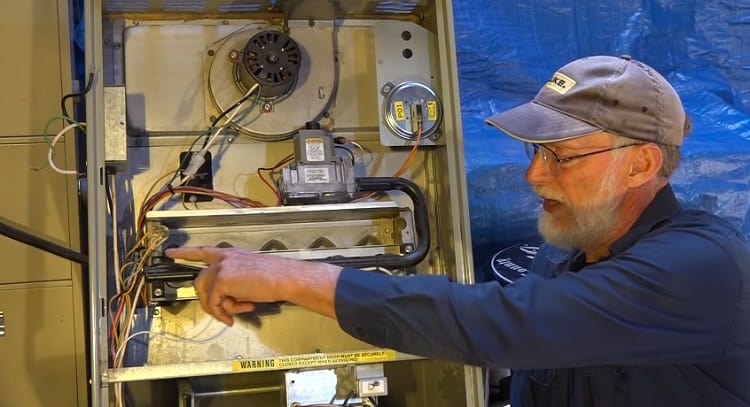
There are four different methods of cleaning the here exchanger, and they are:
Mechanical Cleaning
A mechanical surface preparation technique that includes wire brushing, scraping, chipping, and sanding. Although not the best way of surface preparation, it can be used under mild exposure circumstances.
Chemical Cleaning
This is simply cleaning a fouled heat exchanger by dissolving part or all of the components of the solid foulant deposit with a chemical. Cleaning is often performed by pouring the solvent chemical.
Hydroblasting Cleaning
This method uses high-pressure water systems to blast away any debris or deposits accumulated in the tubes. For many years, hydro blasting has been a common method of cleaning tubes.
Ultrasonic Cleaning
The heat exchanger is immersed in an ultrasonic bath with a high-temperature cleaning solution. Ultrasonic cleaning is a very efficient and effective method of removing dirt from shell and tube heat exchangers.
Depending on which furnace heat exchanger you have, one technique is enough to clean the system properly, and sometimes more than one cleaning is needed. Don’t hesitate to get in touch with the manufacturer or a trained professional for a procedure best compatible with your heat exchanger.
How To Know When It’s Time To Clean Your Heat Exchanger
You will know it’s time to clean your heat exchanger if you notice any of the following:
- The heat exchanger does not produce the right amount of temperature. This happens when there’s fouling on the surface of the plates.
- The pressure drops more than specified. This happens when there is fouling is in the channel passage and increasing the gas velocity.
Before you begin, here are a few things you should regarding which cleaning agents to use.
What Cleaning Agent To Use?
It’s important to select suitable cleaning agents for your heat exchanger. Choosing the wrong one can cause damage to the component.
- RYDLYME – To circulate and remove mineral deposits from heat exchanger tubes, RYDLYME is the best. RYDLYME makes cleaning your heat exchangers quick and easy.
- Vinegar – The acidic nature of vinegar is strong enough to dissolve grease, dirt, and grime. As a result, it is an excellent agent for cleaning heat exchangers.
There are other cleaning agents you can use. In case you have no access to any of the cleaning agents mentioned above, contact your dealer or a trained professional for advice on what to use.
How Often Should You Clean the Heat Exchanger?
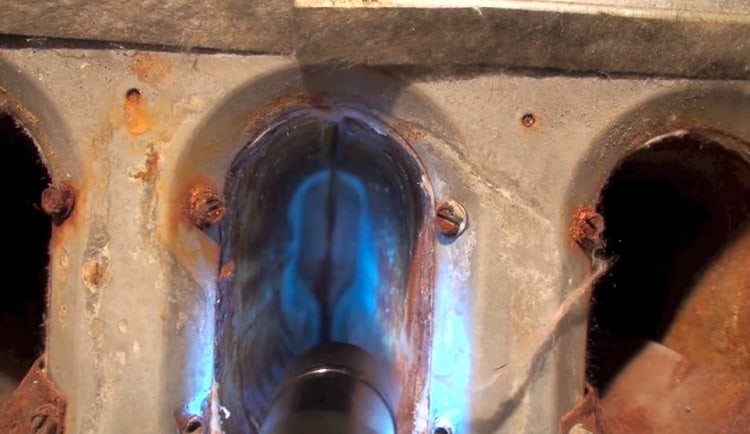
Your furnace’s heat exchanger must be cleaned on a consistent schedule to remove fouling and dirt to maintain maximum effectiveness while decreasing fuel costs. Inspect the heat exchangers at least once a year and clean them when they look dirty.
How to Clean Shell and Tube Heat Exchanger
To clean the tube and shell heat exchanger with RYDLYME, follow the simple steps below:
- Step 1: Disconnect and drain the water from the heat exchanger.
- Step 2: Insert a 1″ ball valve between the isolation valves and the heat exchanger on both the supply and return.
- Step 3: Connect the RYDLYME pump and hoses such that the RYDLYME is pumped in the through supply and out from the return.
- Step 4: Proceed by pumping RYDLYME into the exchanger, according to the manufacturer’s instructions. After putting in the RYDLYME, pump enough water into the tubes to finish the circulation. Please keep in mind that the calcium deposit will take up volume within the heat exchanger, so you won’t be able to add the same quantity of water at first.
- Step 5: As you circulate the solution, the volume will rise, and the product will dissolve the deposits inside the unit and then flushes them out. To compensate for the volume increase, please add water to the circulation vessel as needed. Be careful not to add too much; excessive moisture can cause leaks in the system.
- Step 6: While the solution is being circulated, you should monitor its effectiveness regularly. You can do this by using a pH meter. The product is effective as long as the solution maintains a low pH. If the circulating solution reaches a pH of 5.5 to 7.0 before the recommended time, add extra RYDLYME and increase the circulation period.
- Step 7: After the recommended circulation time has passed, the solution can be flushed to a standard sewer and cleansed with water.
- Step 8: After that, insert the return hose into the drain and fill the circulation container with water until the discharge line runs clean.
Your heat exchanger is now as good as new!
How To Clean The Plate Heat Exchanger
Maintaining a plate heat exchanger is generally easier than other types. Also, it is easier to diagnose problems with them.
The efficiency of your plate heat exchanger will be affected if it is not regularly maintained. This is because of plate fouling. The fouling is less thermally conductive than the plate itself. When dirt accumulates in the grooves of the plates, it reduces the capacity of the heat transfer. So it is vital always to clean the heat exchanger, this way you can avoid permanent damages and save money.
Below are the step-by-step instructions on how to properly clean your plate heat exchanger.
- Step 1: Open the plate pack. You can check your manufacturer’s instructions on how to open yours. It is always best to clean the plates without taking them out of the frames. This helps to avoid damages and accidents, so it is always recommended to be installed where there is enough space.
- Step 2: Now, apply the cleaning agents to each plate. This will loosen any dirt and debris that may have been accumulated.
- Step 3: Next, rinse the cleaning agent with a soft bristle brush and high-pressure washer. Do not use wire brushes or metal pads; they can damage the plates. Also, while rinsing the plates, be careful not to hit the gasket with the washer. Excessive pressure may loosen or remove them.
- Step 4: After you’re done rinsing the plates, secure the heat exchanger and put it back into service.
Your heat exchanger is now as good as new!
FAQs
Question: How Long Can the Heat Exchanger Last?
Answer: The heat exchanger has a life expectancy of 10 to 15years. How well you maintain it determines how long it will last.
Question: Can the Heat Exchanger be Repaired?
Answer: YES, the heat exchanger can be repaired depending on the problem and how intense it is. However, the repair is not the best choice for the heat exchanger. Also, it would cost just as much to get a new heat exchanger.
Question: How Much Does it Cost to Replace the Heat Exchanger?
Answer: The cost of replacing the heat exchanger ranges from $2000 to $3000. But you can get a new furnace for that same price.
Question: How Often Should the Heat Exchanger be Cleaned?
Answer: Your furnace’s heat exchanger must be cleaned at least once a year.
Question: What Will Happen if My Heat Exchanger Cracks?
Answer: If the heat exchanger cracks or rusts, flue gases and carbon monoxide will leak into the home and can cause sickness and possibly death. Therefore, you have to be careful and do not hesitate to contact a trained professional whenever you suspect a leakage.
Conclusion
The life of your furnace depends on how long your heat exchanger can last. Once the heat exchanger goes bad, it cannot be repaired, and replacing will cost as much as a new furnace and sometimes even more. Therefore, a faulty heat exchanger equals a faulty furnace.
With proper maintenance, your furnace’s heat exchanger can last up 15year and more. In order for your heat exchanger to last that long, you must clean and maintain it properly. This article covers everything your need to know about the heat exchanger, including maintenance.
Sources
- ThomasNet
- Turnbull Scott
- CSIDesigns
- Carotek
- Watkins Heating
- Paul Mueller Academy
- Apex Engineering Products
- MERV 8 vs MERV 13 Explained: Which Should You Use and Why? - December 9, 2023
- Inducer Motor Guide: Warning Signs, Troubleshooting and Replacing - December 9, 2023
- Best HVAC Mold Inhibiter Solutions - November 22, 2022

